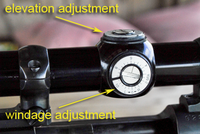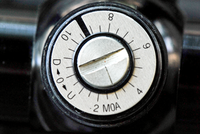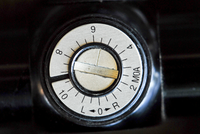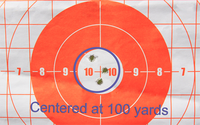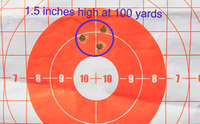Sighting in your rifle
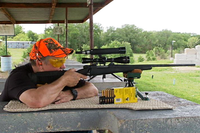
Before hunting you should sight in your rifle and practice shooting so you are confident in your ability and your rifle’s accuracy. The goal is to “zero” your rifle so it will accurately shoot to a point of aim at a specific distance. You may want to zero your rifle so it hits the center of a target at 100 yards if you know that your shots will be at that distance when hunting.
Equipment
- Proper ear and eye protection
- Rifle
- Ammunition- at least 2 boxes of exactly the same ammunition you will be using when you hunt.
- Rifle rest- sandbags or bench rest
- Paper targets with a bullseye in the center and an underlying one inch grid. The grid allows you to calculate what adjustments to make to the scope settings to hit the center of the target.
- Spotting scope to check shots on the target.
- Staple gun and staples to set up targets, if needed at your range.
- Tools- screwdriver or other adjustment tool that fits your type of sights.
- Gun case
Procedure to “Zero” a Rifle
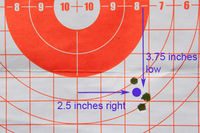 Shoot from a stable platform or bench with a comfortable seat behind.
Shoot from a stable platform or bench with a comfortable seat behind.- Use a stable rest on the bench to anchor the rifle at two points on the rifle stock (not resting under the barrel).
- Begin shooting a target from the rest at a distance of 25 yards.
- Fire three careful shots at the bullseye on target. Load, aim and fire each shot individually (don’t load three rounds in the magazine).
- Check the target for shot placement. The average of the three shots is your approximate point of aim. If the shots did not strike the bullseye, you will need to adjust the sights.
Calculate what adjustments need to be made to bring the point of impact to the center. Adjustments to the “windage” are adjustments to the left and right. Adjustments to the elevation are adjustments up and down. Telescopic sights have screw off covers over the adjustment dials for both windage and elevation (don’t lose them). The dial will be marked indicating which direction to turn for the desired effect. For open sights, adjust the rear sight in the direction you want to move the point of impact. To move the point of impact to the left, move the rear sight to the left, to raise the shot, raise the rear sight adjustment.
- Make adjustments to the sights.
- Fire three more careful shots at the bullseye of the target. Load, aim and fire each shot individually.
- Check the target for shot placement.
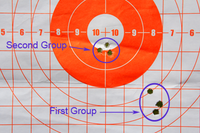
- Make adjustments and repeat firing until you have a centered group on the bullseye.
- Next move to a 100 yard range set up new targets.
- Repeat the same procedure of firing three careful shots at the bullseye, checking placement, making adjustments.
- Take your time and do not rush. If your barrel becomes too hot, take a break and let it cool.
- At 100 yards you will mainly be concerned with adjusting the elevation. Depending on the type of cartridge, what type of game you are hunting and the terrain, you may be satisfied with the rifle zeroed at 100 yards. Many times hunters will sight their rifle in an inch or two high at 100 yards so that it will be centered at 200 yards.
- If the facility has a 200 range, fire from that distance as well, so you can gain an understanding of your sighting at a longer range and the performance of that particular ammunition.
Watch a video on: How to Sight In Your Hunting Rifle.
Practice, Practice, Practice
Becoming an accurate shooter is a skill that must be developed and maintained. The more time you spend shooting the firearm you will be hunting with at different distances, the more confident you will become using it. You will also develop an understanding of your limitations at increasing distances.
You can practice your firing technique using a smaller caliber rifle. For instance, practicing your breathing, trigger squeeze and follow through with a .22 rifle at the rifle range will make you a better shot with your high power deer rifle. Ammunition for a .22 is also comparatively inexpensive and there will be little fatigue from recoil and percussion.
